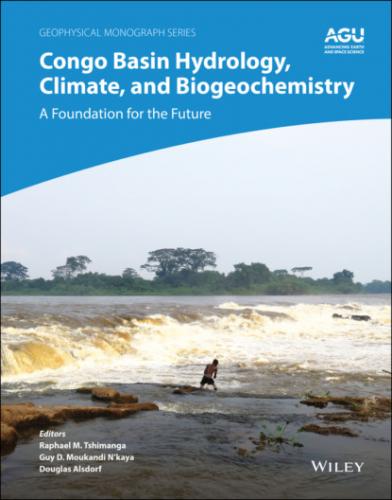6.3.3. Calculation of River Depletion Coefficients
The river depletion coefficients of the Ubangi at Mobaye and the volume mobilized by the basin aquifer were calculated from daily data (according to Cosandey et al., 2003; Goula et al., 2006; Nguimalet & Orange, 2019; Savané et al., 2001). However, numerous gaps in the 1960s with exceptional rainfall and after 1976 shortened the series. This approach makes it possible to assess the contribution of surface runoff on aquifer recharge, by homogeneous hydropluviometric period in this deficit context.
The mathematical expression for the river depletion coefficient is written:
(6.3)
where Qt = discharge at time t, Q0 = initial discharge (discharge at the beginning of the depletion), and k = Maillet depletion coefficient. Maillet’s law is modeled on a single reservoir, which corresponds to all the aquifers contributing to flows in the watershed under study (Goula et al., 2006; Nguimalet & Orange, 2019). The integration of this equation over the interval [0, +] gives an estimate of the volume mobilized from the aquifers in the watershed, i.e.:
(6.4)
6.4. RESULTS
6.4.1. Interannual Evolution of Rainfall and Annual Flows of the Ubangi River at Mobaye
The average interannual rainfall on the Ubangi basin at Mobaye is 1,506 mm over the period 1938–2015. On the one hand, the search for breaks with Hubert’s segmentation reveals two breaks (1968 and 2006) and thus three homogeneous periods (1938–1968, 1969–2006, and 2007–2013). On the other hand, a single break appears in 1969 with the Pettitt and Lee‐Heghinian tests (Table 6.3). This time series is thus characterized by a definite rainfall break in 1968/1969 (Figure 6.3), marking the passage from a previous wet period to a dry period, and a probable second break in 2006 to be confirmed in the future, and which would characterize the return to a wetter period. The average rainfall amounts for the periods 1938–1968, 1969–2006, and 2007–2015 are 1,568 mm, 1,436 mm, and 1,583 mm respectively. The dry period of 1969–2006 corresponds to a reduction of 8% in rainfall compared to the previous period. And the current wet period (2007–2015) describes a 10% increase in rainfall compared to the previous period.
Table 6.3 Statistical segmentation of annual rainfall in the Ubangi basin at Mobaye (1938–2015), and in the upstream basins from 1951–1995 (in the Mbomu basin at Bangassou and Zemio, and in the Kotto basin at Kembe and Bria).
| Hydrological basins | Interannual average (mm) | Pettitt | Lee and Heghinian | Segmentation of Hubert (mm) | Standard Deviation | Hydro‐climatic trends | P divided by interannual average (%) |
|---|---|---|---|---|---|---|---|
| Ubangi at Mobaye (403,800 km2) | 1,506 | 1969 | 1969 | 1938–1968: 1,568 1969–2006: 1,436 2007–2013: 1,583 | 109 88 81 | Wet Dry Wet | +4 –5 +5 |
| Mbomu at Bangassou (115,000 km2) | 1,491 | 1970 | 1951–1994: 1,851 | ||||
| Mbomu at Zemio (29,300 km2) | 1,421 | 1970 | 1951–1994: 1,748 | ||||
| Kotto at Kembe (77,500 km2) | 1,348 | 1969 | 1969 | 1948–1980: 1,458 1981–1991: 1,306 1992–1993: 1,577 | 94 89 32 | Wet Dry Wet | +2 –8 +11 |
| Kotto at Bria (61,500 km2) | 1,348 | 1967 | 1967 | 1948–1966: 1,436 1967–1991: 1,267 1992–1993: 1,515 | 94 105 83 | Wet Dry Wet | +7 –7 +12 |
Figure 6.3 Rainfall index and flow index of the Ubangi basin at Mobaye, 1938–2015.
The 1938–2015 time series of annual flows from the Ubangi at Mobaye is marked by a sharp decline in flows in 1970 (Figure 6.2). Statistical tests indicate only one break with the Pettitt and Lee‐Heghinian tests: it is noted in 1981 on the 1938–2015 series, and in 1970 on the 1948–1995 series. And Hubert’s segmentation describes five homogeneous periods for the two series tested (1938–2015 and 1948–1995) but only the years 1968 and 1980 appear for the two hydrological series tested, attesting to the importance of the statistical break at these two dates. Three hydroclimatic periods are thus retained for the Ubangi at Mobaye (Table 6.4): 1954–1968, 1969–1980, 1981–2013, with interannual mean flows of 3,919 m3/s, 2,986 m3/s (–24%) and 2,372 m3/s (–21%), respectively.
6.4.2. Interannual Evolution of Rainfall and Annual Flows in Sub‐Basins of the Ubangi at Mobaye
The rainfall series of the Uele basin and the Mbomu basin at Bangassou have a similar evolution to that of the Ubangi basin at Mobaye, and to a lesser extent the Kotto basin at Kembe. On the other hand, the rainfall series of the Mbomu at Zemio and the Kotto at Bria do not show a clear separation between a wet and a dry phase (Figure 6.4). The last two basins drain the wooded and shrubby savannah, while the first two are of East–West extension and drain a significant part of the
